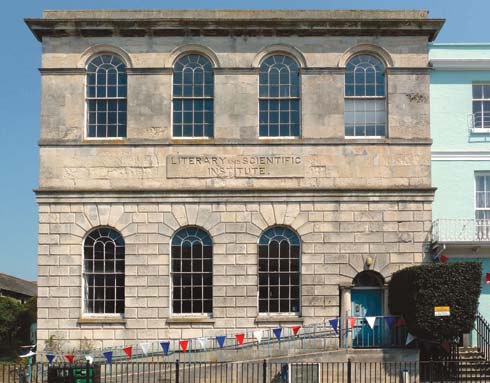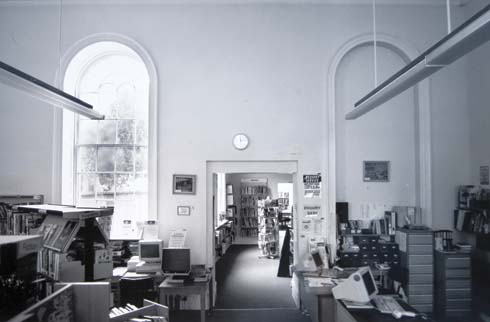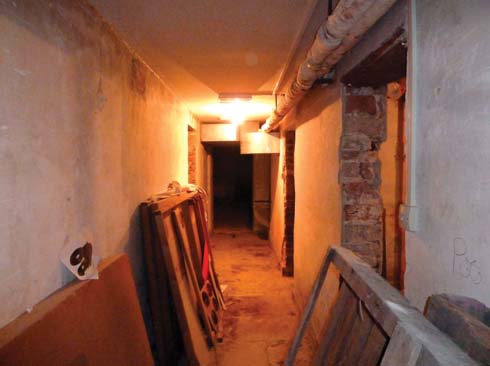From ‘at risk’ to ‘at the heart of Bridport’
Tamsin Chandler charts the rise, fall and rise of the town's Literary & Scientific Institute
Published in October ’13
It has been a library, an art school, a barracks, a quartermaster’s store and, of course, a Literary and Scientific Institute, before becoming a building designated as ‘at risk’ by English Heritage, but Bridport’s LSI is on the road to recovery.
For the past sixteen years, Bridport’s historically significant and architecturally impressive Literary and Scientific Institute (LSI) has stood empty in its prominent East Street position – slowly deteriorating through lack of use and funding; its most recent tenant, the town’s public library, left the LSI in 1997.
The building’s neglect is poised, however, to become anything other than the final chapter in its fascinating history. A dedicated group, led by the Bridport Area Development Trust (BADT), is well on the way to securing full funding to revive the landmark, to restore the building’s Grade II listed structure and to re-establish it as (a financially viable) centre of education and community
focus. To cover what will be significant running costs, the LSI will lease space for community groups, education providers and creative businesses – functions for which a clear demand has been established in the town.
Crystal Johnson, an Arts and Heritage Consultant, is one of the dedicated individuals involved in the project. Her enthusiasm for the restoration and her faith in the potential of a revived Institute, since her appointment as Project Coordinator in 2012, are palpable. In 2010, the newly formed BADT took on the challenge of raising money to restore the building and return it to community use, the cost of which was then estimated at £2.4million. The trust succeeded in securing ‘Stage-One’ approval for a £1.2million grant from the Heritage Lottery Fund, along with financial commitments from Dorset County Council, West Dorset District Council, Bridport Town Council, the Architectural Heritage Fund, English Heritage and the Andrew Lloyd Webber Foundation. A business plan and conservation plan are now being drafted, as the project team works towards gaining Stage 2 funding in the Summer of 2014. Both of these have been informed and guided by conversations and consultations with a variety of organisations, schools and colleges, small businesses and, particularly, the town’s people. The team has so far managed to raise 91.7 per cent of the required funding, and has another year to raise the remaining £200,000 via fundraising events and from public and private donors.
The building is a vital landmark in Bridport’s social and industrial history and is much loved by the people of Bridport. Its history is indeed fascinating, in some ways a physical embodiment of times of both progress and setback experienced by the town as a whole. Originally founded as a Mechanical Institute offering training to working men in 1834, it was reconstituted in accordance with the Literary and Scientific Institutions Act passed by Parliament in 1854, stating its objective as being to encourage: “the intellectual and moral improvement of all classes and the cultivation of Literature, Science and Art”. It went on to co-house the Bridport School of Art from 1865. These two providers of education functioned side-by-side for a number of years, with the art school becoming more influential over time and producing some artists of real significance. Probably the most notable student at the School was Francis H (“Fra”) Newbery who, following an apprenticeship at the School of Art, qualified as an art master in early 1875. He was appointed assistant master at Bridport School of Art, helping it win significant national awards in Competition with other schools of art. Newbery later became Director of Glasgow School of Art, credited with bringing Charles Rennie Mackintosh and a number of his contemporaries to international fame and recognition.

During World War 2 the LSI played host to the men of the Medical Detachment of the 2nd Battalion of the 16th Infantry of the US Army
From 1922 until the outbreak of World War 2 in 1939, the building provided accommodation for a men’s club; from 1939-45, at least part of the building was requisitioned for war purposes. It was used temporarily by American troops (including the Medical Detachment of the 2nd Battalion of the 16th Infantry) stationed in Bridport ahead of the Normandy landings in 1944. The Reading Room was used as a Red Cross recreational centre for the American soldiers and the first floor was, for a time, used as a quartermaster’s store for the borough’s evacuation scheme.
After the war, part of the upstairs was used by the British Red Cross as a depot; in terms of its primary purpose, however, local interest had declined and the institute once again ran into financial difficulties. By 1950, the institute’s committee concluded that its financial position was so weak that it could not continue; responsibility for the building was assumed by Dorset County Council and the building served as the town’s public library from 1952 to 1997.

This image of the staircase of the Literary and Scientific Institute shows the interior as it was in the 1980s
For five years the future of the building was uncertain – various groups occupied parts of the building and feasibility studies were conducted without outcome. In 2002, the uncertainty gave way to a more threatening possibility when the building was declared unsafe and placed on the ‘at-risk’ register by English Heritage. This situation was further complicated by a claim that, since the charitable purposes of the Trust had failed, the building should therefore revert to the Elphinstone family. In 2008 the County Council sought guidance from the High Court as to its duties with regard to the Institute.
In 2008/9 an enquiry from the Bridport Local Area Partnership, on behalf of a number of local cultural and community organisations, along with a firm expression of interest from the newly formed Bridport Area Development Trust, led to the future looking rosier.
At the Bull Hotel, opposite the LSI, Crystal discusses the project’s progress; the plans for the restoration and functions of the Institute are ambitious, well-researched, community-oriented and, most importantly, realistic. Once the conservation and business plans are completed – and Stage 2 funding is achieved, Crystal explains, work will begin on restoring the structure. This work will remain true to the heritage of the building and the town’s principle industry – net and rope making, whilst, she explains, bringing the institute into the 21st century with an emphasis on technology and higher skills learning: ‘Bridport already has a wonderful museum so we are not looking to replicate that sort of experience, although the heritage of the building will be honoured and reflected in any restoration work carried out. The feedback I have received from the community is primarily relief that this much-loved building is being saved. We want to see its original function as a place of education retained, but revamped to serve modern purpose and to benefit as many in the community as possible.’
Although the objectives for the building remain flexible, it is planned that the LSI will house educational/training rooms and facilities for school, college and private sector use with some dedicated small office space and a central café providing a social hub. The principle intention behind planning the LSI’s renewed purpose is, as Crystal puts it, ‘to fill in any gaps’.
To this end, the level of community discussion and collaboration has been long and thorough, trying to find where gaps exist in the community and responding to them: ‘Small office space, for instance, is in very short supply in Bridport,’ says Crystal, ‘We will be able to offer a workspace for start-ups, small businesses or freelancers, for example. Likewise, we plan to provide space for lectures, adult training and further development for people who wish to expand on their existing skills or perhaps specialise in a particular area.’
There will be open public access to key areas of the LSI building, including full disabled access for the first time in the building’s history. The look and feel of the café to be located at ground floor level will reflect the industrial heritage and present day story of the building and the town. The café will also serve as a venue for talks and lectures in the tradition of the institute,focusing on economic development, skills and culture. On the challenge of remaining true to the building’s history while ensuring its relevance in today’s world, Crystal says: ‘We aim to fulfil some of the town’s unique needs by creating a communal learning and working space with a definite aspirational quality – rich with heritage but, above all, creative with a focus on modern
life and with eyes to the future.’
Although the bulk of the funding has been raised, success for the Stage Two Heritage Lottery application in 2014 will depend on proving community support for the restoration through fundraising activities, both large and small. The community has responded generously and support from local businesses is also welcomed in raising the final £200,000 to meet the fundraising target.
The response from schools, colleges, local businesses and organisations – the building’s prospective clients – has also been both enthusiastic and proactive from the outset, with input encouraged by the team at every stage of the planning process. The project team includes a conservation consultant and an architect who will work closely with Crystal and Charles Wild, Chair of the BADT, over the next year. Details such as breakdown of the internal space have not yet been decided – similarly, it is seen as important that plans for the building remain flexible and open to further discussion, if required, ensuring the Institute retains its foremost relevance and role – a place which serves the needs of Bridport and its community and, in line with its original purpose, provides learning and inspires personal and professional development. It will once again – in terms of education, skills and business, be at the heart of Bridport.
• For more information on, or for details of how to donate to, the LSI’s renaissance, visit www.bridportadt.org.uk





